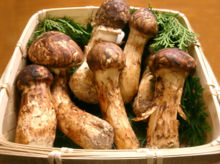Matsutake
| Matsutake | |
|---|---|

| |
| Matsutake | |
| Scientific classification | |
| Domain: | Eukaryota |
| Kingdom: | Fungi |
| Division: | Basidiomycota |
| Class: | Agaricomycetes |
| Order: | Agaricales |
| Family: | Tricholomataceae |
| Genus: | Tricholoma |
| Species: | T. matsutake
|
| Binomial name | |
| Tricholoma matsutake | |
| Synonyms | |
| Tricholoma matsutake mycorrhizal | |
|---|---|
| Edibility is choice | |
| Matsutake | |||||
|---|---|---|---|---|---|
| Japanese name | |||||
| Kanji | 松茸 | ||||
| Hiragana | まつたけ | ||||
| Katakana | マツタケ | ||||
| |||||
Matsutake (Japanese: 松茸/マツタケ), Tricholoma matsutake, is a species of choice edible mycorrhizal mushroom that grows in Eurasia and North America. It is prized in Japanese cuisine for its distinct spicy-aromatic odor.[3][4]
Etymology
The common name and specific epithet, matsutake, in use since the late
Similar species
In Japan, several closely related species have been found, including Tricholoma bakamatsutake (baka-matsutake – 'stupid matsutake' in Japanese), Tricholoma fulvocastaneum (nise-matsutake – 'fake matsutake'), and Tricholoma robustum (matsutake-modoki – 'imitation of matsutake'). Of those species, only baka-matsutake has a taste similar to that of matsutake. Both baka-matsutake and nise-matsutake grow in Fagaceae forests, while matsutake-modoki grows in the same pine forests as the genuine matsutake.[6]
In the North American
Distribution and habitat
Matsutake mushrooms grow in East Asia, South Asia (Bhutan), and Southeast Asia (Laos), parts of Europe such as Estonia, Finland, Norway, Poland, Sweden, and along the Pacific coasts of Canada and the United States.
Matsutake mushrooms grow under trees and are usually concealed under
Ecology
The candy cane plant or sugarstick,
Matsutake are hard to find because of their specific growth requirements, the rarity of appropriate forest and terrain, and competition from wild animals such as squirrels, rabbits, and deer for the once-yearly harvest of mushrooms. Domestic production of matsutake in Japan has also been sharply reduced over the latter half of the 20th century due to the pine-killing nematode Bursaphelenchus xylophilus.
Uses
The annual harvest of matsutake in Japan is now less than 1,000 tons, with the Japanese mushroom supply largely made up by imports from China, Korea, the Pacific Northwest, British Columbia, and northern Europe.[12] This results in prices in the Japanese market highly dependent on quality, availability, and origin that can range from as high as $1,000 per kilogram ($450 per pound) for domestically harvested matsutake at the beginning of the season to as low as $4.41/kg ($2/lb), though the average value for imported matsutake is about $90/kg ($41/lb).[13]
In the 1940s, the abundance of the mushrooms in Japan made them accessible to the general public after long being considered a luxury good, but after the decline of these mushrooms in the region, international trade for them created a fluctuating market that sometimes became very lucrative for the regions of the world that these mushrooms grow in, such as the Yunnan province of Southwest China. Very few countries other than Korea had a preexisting economy for matsutake, and Japanese speculators scoped out regions to market the fungi. Certain regions garner a higher price as well, with regions such as North America seeing a higher price by weight than regions such as those in Southwest China.[citation needed]
The price gathered for matsutake in Japan can vary based on the state of the mushroom. Frozen or dried matsutake are less sought after than fresh ones in luxury markets, meaning that the international trade must be done at a quick pace to keep the mushrooms from decaying.[14]
See also
- Himematsutake: the "princess matsutake"
- List of Tricholoma species
- Medicinal fungi
- The Mushroom at the End of the World – 2015 book by anthropologist Anna Tsing
References
- . Retrieved 19 November 2021.
- ^ a b c "Tricholoma matsutake (S.Ito & S.Imai) Singer". www.gbif.org.
- ISBN 978-0-313-32438-3.
- ^ "Play That Fungi Music". Archived from the original on May 17, 2010.
- ^ "Matsutake". Merriam-Webster Dictionary. 2021. Retrieved 4 October 2021.
- ISSN 1340-3540.
- S2CID 205448035.
- S2CID 83741330.
- ^ Ashburne, John, "In search of the Holy Grail of mushrooms", The Japan Times, 16 October 2011, p. 7.
- ^ a b 刘玉波 (2022-12-12). "赤松赤胆忠心松茸共生共荣" (in Chinese). www.forestry.gov.cn. Retrieved 2023-02-05.
- ^ Moore, Andy. "Allotropa Virgata". Matsiman.com. Archived from the original on 2001-10-07. Retrieved 2021-09-26.
- ^ (in Japanese) 輸入マツタケに異変 中国産激減、フィンランド参戦, J-CAST, 2007/9/26.
- ^ Matsutani, Minoru, "Japan's long love affair with 'matsutake'", The Japan Times, 9 November 2010, p. 3.
- ^ "NOTES", What a Mushroom Lives For, Princeton University Press, pp. 213–234, 2022-04-26, retrieved 2023-12-01
External links
 Media related to Tricholoma matsutake at Wikimedia Commons
Media related to Tricholoma matsutake at Wikimedia Commons

